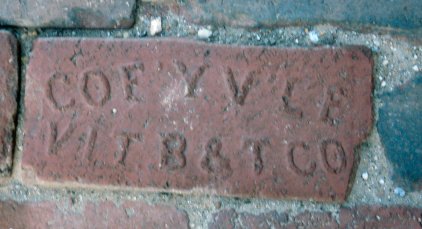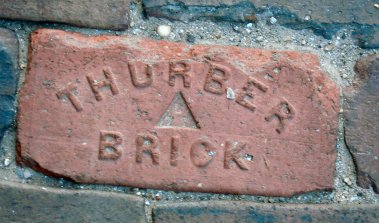Although the persistent rains of the
summer of 2007 might have made us think that the recent awareness of
global warming has been validated, rain and its companion, mud, have
been the bane of Houstonians from the very beginning.
As early as 1837, when John James Audubon visited the town of Houston, he wrote of his displeasure with the mud in the streets. He was not impressed with the town under construction on the soggy prairie. Later, in the mid-nineteenth century, the local firefighters called Houston the "Mud-Hole" because of the difficulty they had pulling their apparatus through the often muddy streets.
Attempts to solve the problem of muddy streets by paving with shell or wooden planks were largely unsuccessful. In the spring of 1882, Houston Daily Post referred to Houston as "a huddle of houses arranged on unoccupied lines of black mud." But, by the end of 1882, two blocks of Main Street had been paved with limestone squares laid over a gravel base. Fifteen blocks of the adjoining Franklin Avenue and Congress Avenue were paved with gravel.

The city continued to try various materials for street paving in order to improve the situation of the streets, and by 1903, Houston had twenty-six miles of paved streets including nine of brick, six of asphalt, six of gravel, three of bois d'arc blocks and one of macadam. By 1915, Houston had 196 miles of paved roads.
Bricks were a very popular material for paving roads and streets from the late 1890's to the 1920's. During the renovations of Commerce Avenue in 2005, segments of the street were re-paved with bricks salvaged from this earlier period of paving. Two of the more common bricks were manufactured by famous brick companies of the period, the Coffeyville Vitrified Brick and Tile Company and the Thurber Brick and Tile Company.
Coffeyville, Kansas had large deposits of shale in the area and a number of brick plants were in operation there during the late 1890's and early 1900's. The Coffeyville Vitrified Brick and Tile Company is well represented among the paving stones at Houston's important commercial intersection of Commerce Avenue and Main Street.
 The other brick company to supply road paving bricks to
Houston was the Thurber Brick and Tile Company. In 1897, the owners of
the coal company of Thurber, Texas began to manufacture bricks to take
advantage of the enormous supplies of shale nearby. The company
produced 80,000 bricks per day and specialized in road paving bricks.
After the unions negotiated a contract at the brick plant in 1903,
Thurber bricks were impressed with a triangle and the letters TBT
(Thurber Brick and Tile), and these are the bricks found in the Houston
street.
The other brick company to supply road paving bricks to
Houston was the Thurber Brick and Tile Company. In 1897, the owners of
the coal company of Thurber, Texas began to manufacture bricks to take
advantage of the enormous supplies of shale nearby. The company
produced 80,000 bricks per day and specialized in road paving bricks.
After the unions negotiated a contract at the brick plant in 1903,
Thurber bricks were impressed with a triangle and the letters TBT
(Thurber Brick and Tile), and these are the bricks found in the Houston
street.
Around the turn of the twentieth century, brick making was one of the leading industries in Texas, second only to car building and shop construction by the railroads. The use of paving bricks for streets and roads was in its heyday. However, after the First World War and the rise of the oil industry, the use of oil-based artificial asphalt became more popular as a street paving material. The paving brick businesses declined rapidly and companies, such as Thurber Brick and Tile in 1930, closed their kilns.
Of course, now the problem is not mud, but drainage.
All material printed on
this
page
and this web site is copyrighted. All rights reserved.As early as 1837, when John James Audubon visited the town of Houston, he wrote of his displeasure with the mud in the streets. He was not impressed with the town under construction on the soggy prairie. Later, in the mid-nineteenth century, the local firefighters called Houston the "Mud-Hole" because of the difficulty they had pulling their apparatus through the often muddy streets.
Attempts to solve the problem of muddy streets by paving with shell or wooden planks were largely unsuccessful. In the spring of 1882, Houston Daily Post referred to Houston as "a huddle of houses arranged on unoccupied lines of black mud." But, by the end of 1882, two blocks of Main Street had been paved with limestone squares laid over a gravel base. Fifteen blocks of the adjoining Franklin Avenue and Congress Avenue were paved with gravel.

The city continued to try various materials for street paving in order to improve the situation of the streets, and by 1903, Houston had twenty-six miles of paved streets including nine of brick, six of asphalt, six of gravel, three of bois d'arc blocks and one of macadam. By 1915, Houston had 196 miles of paved roads.
Bricks were a very popular material for paving roads and streets from the late 1890's to the 1920's. During the renovations of Commerce Avenue in 2005, segments of the street were re-paved with bricks salvaged from this earlier period of paving. Two of the more common bricks were manufactured by famous brick companies of the period, the Coffeyville Vitrified Brick and Tile Company and the Thurber Brick and Tile Company.
Coffeyville, Kansas had large deposits of shale in the area and a number of brick plants were in operation there during the late 1890's and early 1900's. The Coffeyville Vitrified Brick and Tile Company is well represented among the paving stones at Houston's important commercial intersection of Commerce Avenue and Main Street.
 The other brick company to supply road paving bricks to
Houston was the Thurber Brick and Tile Company. In 1897, the owners of
the coal company of Thurber, Texas began to manufacture bricks to take
advantage of the enormous supplies of shale nearby. The company
produced 80,000 bricks per day and specialized in road paving bricks.
After the unions negotiated a contract at the brick plant in 1903,
Thurber bricks were impressed with a triangle and the letters TBT
(Thurber Brick and Tile), and these are the bricks found in the Houston
street.
The other brick company to supply road paving bricks to
Houston was the Thurber Brick and Tile Company. In 1897, the owners of
the coal company of Thurber, Texas began to manufacture bricks to take
advantage of the enormous supplies of shale nearby. The company
produced 80,000 bricks per day and specialized in road paving bricks.
After the unions negotiated a contract at the brick plant in 1903,
Thurber bricks were impressed with a triangle and the letters TBT
(Thurber Brick and Tile), and these are the bricks found in the Houston
street.Around the turn of the twentieth century, brick making was one of the leading industries in Texas, second only to car building and shop construction by the railroads. The use of paving bricks for streets and roads was in its heyday. However, after the First World War and the rise of the oil industry, the use of oil-based artificial asphalt became more popular as a street paving material. The paving brick businesses declined rapidly and companies, such as Thurber Brick and Tile in 1930, closed their kilns.
Of course, now the problem is not mud, but drainage.